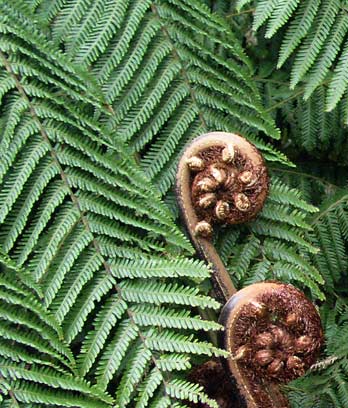Story summary
Ferns in New Zealand
New Zealand has 194 native species and 35 introduced species of ferns and lycophytes. They range from freshwater to alpine habitats, and from just a few millimetres long to 20-metre-tall tree ferns. Just under half of the native species cannot be found anywhere else.
What are ferns and lycophytes?
They are green plants with no flowers that reproduce by tiny cells called spores, rather than by seeds like flowering plants. Ferns and lycophytes have three main parts:
- Stem: can be creeping or climbing, or upright.
- Fronds: usually on a stalk, with a flat blade divided into segments. New fronds unfurl from a fiddlehead or koru.
- Spore-producing structures attached to fertile fronds.
Life cycle
Spore-bearing capsules called sporangia appear on the edges or undersides of mature fronds. When they split open, the spores are released. These germinate in damp places to become tiny heart-shaped plants. When it rains, male sex cells are carried by the water towards female egg cells. The fertilised eggs grow into leafy fern plants.
Many ferns also have non-sexual or vegetative means of production. They produce buds or tiny copies of themselves, which drop to the ground and take root.
Where they grow
Ferns and lycophytes grow in most places in New Zealand, except on the highest mountain tops. Some live on exposed coasts and have leathery fronds to stop them from drying out in the wind. Others cling to the trunks of forest trees, some grow in lakes, and others in the alpine zone.
Māori uses
Traditionally, Māori ate roots of bracken, and used ferns for medicine. They built houses from tree fern trunks. Stems of puakarimu, a clubmoss, were woven with flax to make waterproof capes.
Ferns in today’s culture
The fern has become a national symbol. It is on the uniforms of most national sports teams, and in the name of two women’s teams: the Silver Ferns netball team and the Black Ferns women’s rugby team. The fern logo is associated with many New Zealand products, and ferns have featured on coins, banknotes, and the country’s coat of arms.





